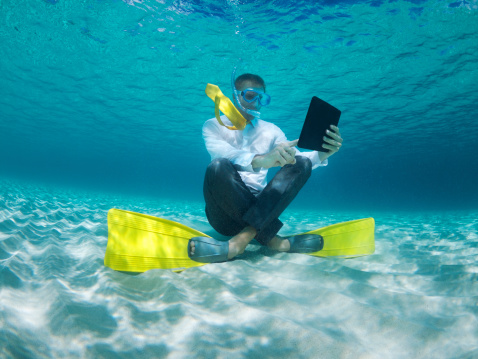You can get Wi-Fi just anywhere you wish. Whether you are travelling by train, visiting a park or relaxing in your house you can make use of this technology. How about getting wifi under the sea? Yes, the researchers are now working with Wi-Fi network to develop ‘deep sea internet' connection.
A tech-geek can check emails and Facebook underwater but it can also offer excellent technological breakthroughs. You can monitor sea pollution, detect tsunami, conduct offshore oil inspection and explore natural gas and other beneficial activities. With help of this wireless network, you can predict the threats of underwater earthquakes as well as tsunamis and also track the ocean life. Do you want to know how this technology works? Check it out in the following.
Functioning of underwater wi-fi technology:
Unlike common wi-fi that uses radio waves, the submerged wireless network uses sound waves. The radio waves have the capacity to penetrate sea water but within limited stability and range. The sound waves offer better option and the submarine navigation network that use sonar can easily attest to these waves. A sensor can be dropped into the water and also relay buoy is placed on surface of the lake. The signal from Wi-Fi radio transmits to buoy that easily converts it into sound waves for underwater sensors. The sensor is bi-directional and two-way communication can be easily established.
Here are a few benefits of using underwater internet with Wi-fi technology.
Save you from the maritime disasters!
Underwater wireless network can give you unprecedented ability to gather as well as analyze essential data from ocean in the real time. When tsunami or any underwater disaster occurs, you can easily pass the information to any person with help of computer or Smartphone and save lives of many people.
Enables smart data sharing from underwater
The wireless networks that work on land depend on the radio waves for transmitting data via antennae as well as satellites. But the radio waves do not work properly under the sea. Therefore the topnotch scientific agencies that focus on conditions of atmosphere and oceans rely on sound wave centric techniques to establish communicate under the sea. They rely on sound waves for sending data from tsunami or earthquake sensors on sea floor to the surface buoys. These buoys convert acoustic waves into the radio waves to send data to satellite that again redirects radio waves to desktops or other land-centric computers.
Although most systems across the world employ this pattern, they find it difficult to share important data amongst themselves. The reason is that each and every system has different infrastructure. In such a scenario the current underwater internet framework is expected to solve the issue. It is capable of transmitting data from existing sensor networks under the sea to the smartphones, laptops as well as other wireless equipment in the real time.
Wide-ranging applications:
Underwater wi-fi has wide-ranging applications. It includes linking the buoy networks for detecting tsunamis or other maritime issues. It also helps you to collect authentic oceanographic data and help in functioning of other relevant functions. Such framework encourages collaboration amongst the researchers and eliminates duplicate deployment of sensors as well as other essential devices.
Plus, this wireless networking has multiple applications to facilitate certain military and law enforcement activities. For instance, the drug smugglers often deploy the makeshift submarines to ferry drugs and narcotics secretly. A robust underwater sensor can help you to spot these vehicles. This type of frameworks is beneficial for energy and power industry that relies on the seismic waves to search for natural gas as well as underwater oil. You can also use it for tracking aquatic mammals as well as fishes and find different ways to protect these creatures from shipping traffic as well as other imminent dangers. For example, scuba divers often use wireless technology to do underwater research. If these divers see rare species or come across shipwrecks they try to find if they discover something more. Instant research means that scuba diving along with Wi-Fi technique may keep you well informed about new creatures and expand your knowledge.
Explore the benefits of underwater Wi-Fi and get the most out of your sea voyage.
Steven Scheck is the Principal of InspireWiFi, the nationwide leader of Wi-Fi networks for the multifamily, hospitality and healthcare industries.








